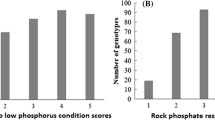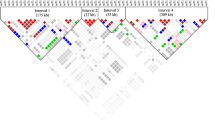Abstract
Cowpea (Vigna unguiculata L. Walp) is a legume consumed for its high protein content. It provides nutrient-dense food opportunities for human consumption. Iron deficiency chlorosis (IDC) manifests as yellowing of the leaves and reduced plant growth, resulting in reduced yield potential. Use of IDC tolerant cowpea cultivars is an efficient method to address this problem. The objectives of this study were to conduct a population structure analysis, to carry out an association mapping study, and to identify SNP markers associated with IDC tolerance in cowpea. A total of 353 cowpea accessions were evaluated for tolerance/susceptibly to low soluble iron conditions on higher pH soils. A total of 1006 SNP markers postulated from genotyping-by-sequencing were used after filtering for population structure and association analysis studies. Results revealed that: (1) a substantial variability in degree of tolerance to low soluble iron conditions was found among the cowpea accessions; (2) delta K peak was identified at K equal to 2, indicating two subpopulations within the cowpea accessions tested for adaptation to IDC, a second delta peak corresponding to K equal to 3 was also found; and (3) nine SNP markers, C35081162_3130, Scaffold16136_2033, Scaffold1764_4741, Scaffold18262_4480, Scaffold30165_15499, Scaffold47194_5530, Scaffold73235_6677, Scaffold77932_9959, and Scaffold86559_7193, were significantly associated with IDC tolerance in cowpea. These results can be used as tools to select cowpea genotypes tolerant to IDC under low soluble iron conditions.




Similar content being viewed by others
References
Bastien M, Humira S, François B (2014) Genome wide association mapping of Sclerotinia sclerotiorum resistance in soybean with a genotyping-by-sequencing approach. Plant Genome. https://doi.org/10.3835/plantgenome2013.10.0030
Bhattarai G, Mehlenbacher SA (2017) In Silico development and characterization of tri-nucleotide simple sequence repeat markers in hazelnut (Corylus avellana L.). PLoS ONE 12:e0178061
Borlotti A, Vigani G, Zocchi G (2012) Iron deficiency affects nitrogen metabolism in cucumber (Cucumis sativus L.) plants. BMC Plant Biol 12:189
Bradbury PJ, Zhang Z, Kroon DE, Casstevens TE, Ramdoss Y, Buckler ES (2007) TASSEL: software for association mapping of complex traits in diverse samples. Bioinformatics 23:2633–2635
Chen S, Kurle JE, Stetina SR, Miller DR, Klossner LD, Nelson GA, Hansen NC (2007) Interactions between iron-deficiency chlorosis and soybean cyst nematode in Minnesota soybean fields. Plant Soil 299:131–139
Cortinas-Escobar HM, Scheuring DC, Gerik TJ, Miller JC Jr (1995) Inheritance of resistance to iron deficiency in cowpea. HortScience 30:841
Dixon DP, Edwards R (2010) Glutathione transferases. Arabido Book 8:20131
Earl DA, VonHoldt BM (2011) Structure harvester: a website and program for visualizing structure output and implementing the Evanno method. Conserv Genet Resour 4:359–361
Elshire RJ, Glaubitz JC, Sun Q, Poland JA, Kawamoto K, Buckler ES, Mitchell SE (2011) A robust, simple genotyping-by-sequencing (GBS) approach for high diversity species. PLoS ONE 6:e19379
Evanno G, Regnaut S, Goudet J (2005) Detecting the number of clusters of individuals using the Software structure: a simulation study. Mol Ecol 14:2611–2620
Fang WP, Meinhardt LW, Tan HW, Zhou L, Mischke S, Zhang D (2014) Varietal identification of tea (Camellia Sinensis) using nanofluidic array of single nucleotide polymorphism (SNP) markers. Hortic Res 1:14035
Frota KMG, Soares RAM, Arêas JAG (2008) Chemical composition of cowpea (Vigna unguiculata L. Walp), BRS-Milênio Cultivar. Food Sci Technol 28:470–476
Hale AL, Scheuring DC, Gerik TJ, Hart JD, Miller JC Jr (2000) Further investigations on the genetics of resistance to iron deficiency in cowpea. HortScience 35:560
Hansen NC, Jolley VD, Naeve SL, Goos RJ (2004) Iron deficiency of soybean in the North Central U.S. and associated soil properties. Soil Sci Plant Nutr 50:983–987
Hindt MN, Guerinot ML (2012) Getting a sense for signals: regulation of the plant iron deficiency response. Biochem Biophys Acta 1823:1521–1530
Jadhav RS, Desai A, Soong NW, Farmer WJ, Vishwanatha T, Pasternak JJ (1994) Role of siderophore in iron uptake in Cowpea Rhizobium GN1 (peanut isolate): possible involvement of iron repressible outer membrane proteins. FEMS Microbiol Lett 115:185–189
Jeong J, Guerinot ML (2009) Homing in on iron homeostasis in plants. Trends Plant Sci 14:280–285
Jokar L, Ronaghi A, Karimian N (2015) Effects of different Fe levels from Fe-nano-chelate and Fe-EDDHA sources on growth and some nutrients concentrations in cowpea in a calcareous Soil. J Sci Technol Greenh Cult 6:9–18
Kisha TJ, Sneller CH, Diers BW (1997) Relationship between genetic distance among parents and genetic variance in populations of soybean. Crop Sci 37:1317–1325. https://doi.org/10.2135/cropsci1997.0011183X003700040048x
Kobayashi T, Nishizawa NK (2012) Iron uptake, translocation, and regulation in higher plants. Annu Rev Plant Biol 63:131–152. https://doi.org/10.1146/annurev-arplant-042811-105522
Kumar S, Stecher G, Tamura K (2016) MEGA7: molecular evolutionary genetics analysis version 7.0 for bigger datasets. Mol Biol Evol 33:1870–1874. https://doi.org/10.1093/molbev/msw054
Lander ES, Botstein D (1989) Mapping mendelian factors underlying quantitative traits using RFLP linkage maps. Genetics 121:185–199
Li W, Lan P (2017) The understanding of the plant iron deficiency responses in strategy I plants and the role of ethylene in this process by omic approaches. Front Plant Sci 8:40
Li R, Yu C, Li Y, Lam TW, Yiu SM, Kristiansen K, Wang J (2009) SOAP2: an improved ultrafast tool for short read alignment. Bioinformatics 25:1966–1967
Liu X, Huang M, Fan B, Buckler ES, Zhang Z, Bradbury PJ (2016) Iterative usage of fixed and random effect models for powerful and efficient genome-wide association studies. PLoS Genet 12:e1005767
López-Millán AF, Grusak MA, Abadía A, Abadía J (2013) Iron deficiency in plants: an insight from proteomic approaches. Front Plant Sci 4:254
Mamidi S, Chikara S, Goos RJ, Hyten DL, Annam D, Moghaddam SM, Lee RK, Cregan PB, McClean PE (2011) Genome-wide association analysis identifies candidate genes associated with iron deficiency chlorosis in soybean. Plant Genome 4:154–164
Mduma I, Msuya J, Mwanri AW, Yang RY (2012) Carotenoids retention and in Vitro iron bioavailability of traditional cowpea feaf dishes of rural Tanzania. Int J Food Sci Nutr 63:267–272
Muneer S, Jeong BR, Kim TH, Lee JH, Soundararajan P (2014) Transcriptional and physiological changes in relation to Fe uptake under conditions of Fe-deficiency and Cd-toxicity in roots of Vigna Radiata L. J Plant Res 127:731–742
Okonya JS, Maass BL (2014) Protein and iron composition of cowpea leaves: an evaluation of six cowpea varieties grown in eastern Africa. Afr J Food Agric Nutr Dev 14:2129–2140
Prathet P, Somta P, Srinives P (2012) Mapping QTL conferring resistance to iron deficiency chlorosis in mungbean [Vigna radiata (L.) Wilczek]. Field Crops Res 137:230–236
Pritchard JK, Stephens M, Donnelly P (2000) Inference of population structure using multilocus genotype data. Genetics 155:945–959
Qin J, Shi A, Xiong H, Mou B, Motes D, Lu W, Miller JC Jr, Scheuring DC, Nzaramba MN, Weng Y, Yang W (2016) Population structure analysis and association mapping of seed antioxidant content in USDA cowpea (Vigna unguiculata L. Walp.) core collection using SNPs. Can J Plant Sci 96:1026–1036
Qin J, Shi A, Mou B, Bhattarai G, Yang W, Weng Y, Motes D (2017) Association mapping of aphid resistance in USDA cowpea (Vigna unguiculata L. Walp.) core collection using SNPs. Euphytica 213:36
Ramasamy RK, Ramasamy S, Bindroo BB, Naik VG (2014) Structure plot: a program for drawing elegant structure bar plots in user friendly interface. SpringerPlus 3:431
Santos CAF, Boiteux LS (2015) Genetic control and transgressive segregation of zinc, iron, potassium, phosphorus, calcium, and sodium accumulation in cowpea (Vigna unguiculata) seeds. Genet Mol Res 14:259–268
Shi A, Buckley B, Mou B, Motes D, Morris JB, Ma J, Xiong H, Qin J, Yang W, Chitwood J, Weng Y (2016) Association analysis of cowpea bacterial blight resistance in USDA cowpea germplasm. Euphytica 208:143–155
Singh BB, Ajeigbe HA, Tarawali SA, Fernandez-Rivera S, Abubakar M (2003) Improving the production and utilization of cowpea as food and fodder. Field Crops Res 84:169–177
Sivitz A, Grinvalds C, Barberon M, Curie C, Vert G (2011) Proteasome-mediated turnover of the transcriptional activator FIT is required for plant iron-deficiency responses. Plant J 66:1044–1052
Somta P, Prathet P, Kongjaimun A, Srinives P (2014) Dissecting quantitative trait loci for agronomic traits responding to iron deficiency in mungbean [Vigna radiata (L.) Wilczek]. Agrivita 36:101–111
Srinives P, Kitsanachandee R, Chalee T, Sommanas W, Chanprame S (2010) Inheritance of resistance to iron deficiency and identification of AFLP markers associated with the resistance in mungbean (Vigna radiata (L.) Wilczek). Plant Soil 335:423–437
Tewari RK, Kumar P, Sharma PN (2005) Signs of oxidative stress in the chlorotic leaves of iron starved plants. Plant Sci 169:1037–1045
Wang B, Tan HW, Fang W, Meinhardt LW, Mischke S, Matsumoto T, Zhang D (2015) Developing single nucleotide polymorphism (SNP) markers from transcriptome sequences for identification of longan (Dimocarpus longan) germplasm. Hortic Res 2:14065
Waters BM, Lucena C, Romera FJ, Jester GG, Wynn AN, Rojas CL, Alcántara E, Pérez-Vicente R (2007) Ethylene involvement in the regulation of the H+-ATPase CsHA1 gene and of the new isolated ferric reductase CsFRO1 and iron transporter CsIRT1 genes in cucumber plants. Plant Physiol Biochem 45:293–301
Xiong H, Shi A, Mou B, Qin J, Motes D, Lu W, Ma J, Weng Y, Yang W, Wu D (2016) Genetic diversity and population structure of cowpea (Vigna unguiculata L. Walp). PLoS ONE 11:e0160941
Yamato M, Okimori Y, Wibowo IF, Anshori S, Ogawa M (2006) Effects of the application of charred bark of Acacia mangium on the yield of maize, cowpea and peanut, and soil chemical properties in South Sumatra, Indonesia. Soil Sci Plant Nutr 52:489–495
Zargar SM, Mahajan R, Farhat S, Nazir M (2015) Understanding the role of iron and zinc in animals and crop plants from genomics perspective. Curr Trends Biotechnol Pharm 9:181–196
Zhang C, Römheld V, Marschner H (1995) Retranslocation of iron from primary leaves of bean plants grown under iron deficiency. J Plant Physiol 146:268–272
Zhou L, Matsumoto T, Tan HW, Meinhardt LW, Mischke S, Wang B, Zhang D (2015) Developing single nucleotide polymorphism markers for the identification of pineapple (Ananas comosus) germplasm. Hortic Res 2:15056
Acknowledgements
This work was supported, in part, by the USDA National Institute of Food and Agriculture Hatch Project Accession No. 1002423.
Author information
Authors and Affiliations
Corresponding author
Electronic supplementary material
Below is the link to the electronic supplementary material.
Table S1
Cowpea accession, origin of cowpea accessions, tolerance to iron-deficiency, and iron-deficiency chlorosis scores. (XLSX 18 kb)
Rights and permissions
About this article
Cite this article
Ravelombola, W., Qin, J., Shi, A. et al. Population structure analysis and association mapping for iron deficiency chlorosis in worldwide cowpea (Vigna unguiculata (L.) Walp) germplasm. Euphytica 214, 96 (2018). https://doi.org/10.1007/s10681-018-2176-5
Received:
Accepted:
Published:
DOI: https://doi.org/10.1007/s10681-018-2176-5




